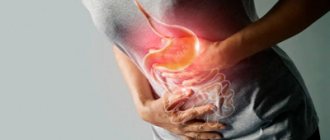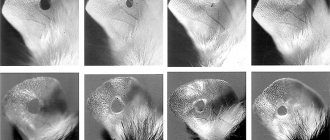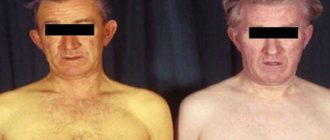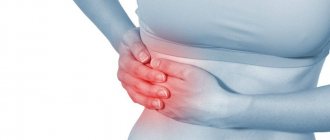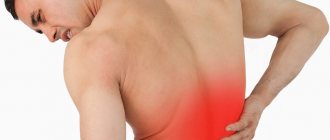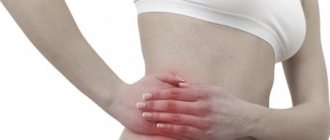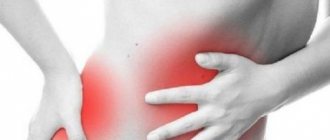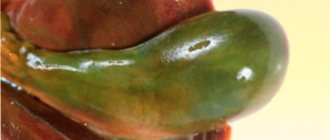The statement of “experts” that their liver hurts after drinking alcohol requires clarification. Firstly, alcohol is not a substance that causes pain when injected. Its action is similar to that of narcotic drugs.
Secondly, the liver is a complex organ; its peculiarity is the absence of pain nerve endings in the parenchyma. They are only available in the capsule. A dense fibrous covering protects the liver cells and responds only to stretching or rupture.
It would be more correct to say that pain in the liver area is caused by diseases accompanied by enlargement of the organ due to inflammation or swelling, injury, or a growing tumor. On what basis alcohol is included among these factors, we will try to find out.
Biochemical transformations of alcohol in the body
Alcohol enters the liver with the blood after partial absorption in the stomach, then in the intestines. The main component of alcoholic beverages is alcohol (ethanol). Although a small admixture of methyl alcohol, chemical additives, and herbal components also has a negative effect. The quality of the snack plays a significant role.
Hepatocytes have a special enzyme (alcohol dehydrogenase). Its biochemical transformation is controlled by strong coenzymes. As a result of the combination with ethanol, acetaldehyde is formed in the cells. Further transformations are provided by oxidative cytoplasmic systems and the enzyme catalase. As a result of the transformation, acetic acid remains.
The reserve of liver enzymes for neutralization lasts for several years. After depletion, irreversible changes occur in hepatocytes. The damaging effects of alcohol when consumed regularly have been proven. In terms of pure alcohol, the maximum dose for men is 80 ml daily, for women - 20–40 ml, and 15 ml per day is enough for a teenager.
Complete restoration of liver cells is possible only at the initial stage of fatty disease
Content:
- How does alcohol affect liver tissue?
- Clinical picture
- Principles of therapy
- The importance of diet
- How to treat the liver after heavy drinking? Effective medicines
One of the functions of the liver is to neutralize toxic substances. But in an alcoholic, this organ can also suffer from toxins. What medications are prescribed to treat the liver after heavy drinking? There is no magic pill, therapy is complex: in addition to synthetic drugs, plant-based medicines, as well as diet therapy, are important. This will be discussed in our article.
What liver pathology is associated with alcohol?
The International Statistical Classification of Diseases includes the term “alcoholic liver disease.” It includes several diseases accompanied by disruption of the structure and function of liver cells. All of them depend on liver disorders after alcohol. Narcologists call them stages.
Steatosis (fatty degeneration) is the easiest option. It is found in all persons who abuse alcohol. No pain. The presence of excess weight and chronic diseases with pathology of fat metabolism enhances the negative effect.
The level of triglycerides in the patient’s body increases, and fatty inclusions in the form of tiny bubbles are deposited in hepatocytes. It is important for a person that at this stage the liver can fully recover a month after quitting alcohol. Continued drinking leads to fatty degeneration. The cells are replaced by adipose tissue, and the organ loses function.
Alcoholic hepatitis is an inflammatory disease of the liver. Accompanied by dull pain in the right hypochondrium, a constant feeling of heaviness. An acute form is possible after a single consumption of alcohol-containing drinks and a chronic course.
Under the influence of acetaldehyde, a leukocyte infiltration is formed in the center of the liver lobules, hepatocytes increase, and special protein inclusions from hyaline (Mallory bodies) are found in the cytoplasm. They surround the cell nucleus and cause irreversible changes in the form of fibrosis against the background of fatty degeneration. Stagnation of bile occurs in the intrahepatic bile ducts.
The inflammatory process is actively supported by:
- the production of autoantibodies and anti-inflammatory cytokines of the immunoglobulin type on the nuclear structures of cells;
- oxygen starvation of hepatocytes due to compression of arterial vessels by edema.
The process does not affect the entire organ at once, but individual areas that are replaced by fibrous tissue. At the same time, healthy tissue, with the support of drugs, is able to maintain liver function for a long time.
Alcoholic fibrosis is a variant of the proliferation of connective tissue without disrupting the structure of the hepatic lobules. Leaves part of the organ's functions intact. The process of fibrosis is facilitated by an imbalance in the intestinal microflora. Some microorganisms are capable of secreting endotoxin, which supports scarring.
Treatment of alcoholic liver disease
Alcoholic cirrhosis differs from previous stages by gradual diffuse damage to the entire organ with the death of hepatocytes and replacement of functioning tissue with scars. The entire structure of the liver is disrupted, the lobules turn into dense nodes. They grow to large sizes.
When the liver loses more than half of its hepatocytes, a person exhibits symptoms of liver failure. Why some patients develop cirrhosis after 5–7 years of alcoholism, and others after 10–15 years, is explained by the state of the body’s immunity and individual protective reactions.
Diagnostics
The effect of alcohol on the liver gives such a pronounced and characteristic clinical picture that doctors usually have no problems identifying the form and stage of the disease.
The main role is given to:
- Survey and collection of complaints.
- The presence of long-term chronic alcoholism.
- Blood tests (described above).
- Detection of elevated bilirubin values.
- Detection of high levels of immunoglobulin A.
Modern diagnostics are based on obtaining the results of computer and microresonance tomography, ultrasound. These techniques allow you to find violations at the very beginning of the process. The data obtained are confirmed by radionuclide methods and biopsy.
Who is at the highest risk of pain?
In men, alcoholism with liver pain develops 3 times more often than in women. In recent years, there has been an increase in adolescents. Drinking non-alcoholic beer containing 5% pure alcohol in large quantities provides a critical dosage. It has been established that with breaks in drinking for 2 weeks, final liver damage is delayed for 10–15 years.
In women, alcohol dependence develops more quickly with subsequent liver changes due to the peculiarity of the enzyme systems that break down ethanol
The liver of those who suffer the most severe damage is:
- with excess weight, lack of protein and vitamins in food;
- do not exclude the use of alcohol substitutes, which additionally affect the organ with toxic substances;
- survivors of viral hepatitis (25% of patients test positive for viral hepatitis C);
- having a hereditary predisposition.
Relevance of the problem
The problem of excessive alcohol consumption and its consequences has long attracted attention in almost all countries of the world. According to official statistics, the highest consumption is observed in European countries, where about 50% (58 million people) drink alcohol excessively. Per capita alcohol consumption among persons over 15 years of age is 11 liters of ethanol per year.
Characteristics of pain syndrome
If the liver hurts after drinking alcohol, but in its absence a person does not feel pain, then several options for damage can be assumed:
- activation of hepatitis with swelling and moderate enlargement of the organ, stagnation of bile and distension of the capsule;
- stimulation of fibrotic disorders in cirrhosis with the formation of portal hypertension, liver enlargement;
- acute poisoning, when pain in the right hypochondrium is caused by gastritis;
- reaction of the gallbladder and ducts to a malfunction of the liver.
The last two forms answer the common question “can the liver hurt badly after drinking alcohol.” Intense pain is caused by the liver only in the case of rapid growth of a tumor, echinococcal cyst, or abscess. In such cases, drinking alcohol stimulates the process, worsens the situation and the patient’s condition. Cholestatic hepatitis occurs with bursting pain in the hypochondrium on the right.
Alcoholic fatty degeneration (AFD)
This pathology is the most common type of toxic damage to liver tissue. Early diagnosis of the disorder is difficult due to minor symptoms. Patients show virtually no complaints.
When interviewed by a doctor, they may report:
- Apathy, poor health, lethargy.
- Periodic feeling of fullness in the stomach even after eating a small amount of food.
- Bloating.
- The release of foul gases.
- Diarrhea.
When examining and palpating the liver, the doctor reveals:
- Organ enlargement.
- Rounded edge.
- Thick consistency.
- Increased sensitivity.
Laboratory diagnostics do not provide any data confirming the presence of pathology. Liver tests remain within normal limits, sometimes slightly beyond the limits. The only factor indicating the disease is the bromsulfophthalein test.
Pathology is detected using:
- Ultrasound data.
- Computer and magnetic resonance imaging.
- Punch biopsy. Pathomorphological examination reveals cells filled with drops of fat, deformation with a displacement to the periphery of the nucleus and formed elements (mitochondria and lysosomes).
AD is a reversible condition. If the patient begins to lead a sober lifestyle, the identified deviations will gradually go away and recovery will begin.
What additional signs indicate alcoholism?
At the stage of steatosis there is no pain, patients rarely feel malaise or nausea. Alcoholic hepatitis occurs in different forms. The most pronounced symptoms are with icteric, cholestatic and fulminant.
- Jaundice - accompanied by pronounced yellowing of the skin and sclera, loss of appetite, weakness, nausea and vomiting, diarrhea.
- With cholestatic hepatitis, in contrast to icteric hepatitis, the skin color is more pronounced, the urine is dark, the feces are gray, the patient has severe itching of the skin, and the temperature rises.
- Fulminant - rapidly progresses, accompanied by hemorrhagic manifestations, kidney damage, increasing liver failure, and toxic effects on brain cells.
In chronic hepatitis with transition to cirrhosis, patients have impaired digestion. Appear: belching, flatulence, decreased appetite, diarrhea alternating with constipation, attacks of nausea and vomiting, weight loss.
Brain intoxication is expressed by:
- sleep disturbance (insomnia at night, drowsiness during the day);
- feeling tired, loss of performance;
- depression, decreased memory, increased irritability.
The bright color of the palmar surface of the hands is considered a symptom of chronic liver damage
The beginning signs of liver failure can be judged by the presence of spider veins on the face and body, redness of the palms and feet, bruising from slight pressure, and the transformation of the fingers into “drum sticks.”
In men, the mammary glands enlarge, fat is deposited on the hips and abdomen, legs and arms become thinner, the testicles atrophy, and potency decreases. The appearance of a large abdomen with an expanded network of saphenous veins around the navel, an enlarged spleen, and vomiting with blood indicate increased pressure in the portal system.
Clinical picture
With the described disorder, the following clinical symptoms occur:
- nagging constant, periodically intensifying pain under the costal arch on the right;
- bitter taste in the mouth;
- deterioration and complete lack of appetite;
- nausea with urge to vomit;
- diarrhea;
- signs of jaundice: a characteristic shade of the skin, visible mucous membranes, darkening of urine (it becomes like beer), discoloration of feces (it can even turn white).
What diseases cause pain in the liver area?
Drinking alcohol can cause exacerbation of chronic pathology of other organs. This must be remembered if pain occurs in the right hypochondrium. Ulcer of the stomach and duodenum - pain on the right is characteristic of damage to the pyloric part of the stomach, bulbitis and ulcers in the initial zone of the duodenum.
Pain will occur 1.5–2 hours after the start of drinking. Very intense, radiating to the navel area and the right side of the lower back. Accompanied by bitter vomiting, belching, and diarrhea. In acute pancreatitis, the pain is intense, girdling in nature, constant nausea, vomiting with bile, diarrhea, bitterness in the mouth, bloating, and increased temperature.
Acute or exacerbation of chronic cholecystitis - manifested by cramping pain in the right hypochondrium with irradiation to the shoulder blades and right lower back. The temperature rises sharply with chills and sweating. Vomiting with bile recurs. Worried about diarrhea or constipation.
Literature:
- Endogenous intoxication syndrome (manual) / S. G. Musselius. — Ed. 2nd, revised and additional - Moscow: Author's book, 2019. - 356 p.
- Chronic alcohol intoxication / A. Ya. Grinenko et al. - St. Petersburg: R. Aslanov Publishing House: Legal Center Press, 2007. - 537 p.
- Differential diagnosis of diseases occurring with jaundice syndrome / V. F. Pavelkina, N. S. Markosyan, N. P. Ampleeva, etc.; Ministry of Science and Higher Education of the Russian Federation, Federal State Budgetary Educational Institution of Higher Education “National Research Mordovian State University named after. N.P. Ogareva.” - Saransk: Mordovian University Publishing House, 2022. - 105 p.
Need some advice?
OR CALL A DOCTOR
CALL!
+7
Etiology
The most obvious reason for the development is long-term abuse of alcoholic beverages. In this case, not only the amount of alcohol matters, but also the frequency of drinking episodes and the specific type of strong drinks. For most people, the critical dose of ethanol is 80–160 g per day over 10–20 years of regular drinking.
But in women, the disease develops when drinking much smaller doses of alcohol (20–40 g per day) and over a shorter period. This is explained by the smaller number of enzymes involved in the breakdown of ethanol. And if therapy is started too late, in 50% of women the pathology progresses to hepatocellular carcinoma, even if they get rid of addiction.
According to experts, one-time alcoholic excesses (even with significant alcohol abuse) are safer, since a rare intake of alcohol gives the liver the opportunity to “recover”, which cannot be said about daily drunkenness.
In addition, the risk of alcoholic liver toxicosis is increased if:
- genetic characteristics due to which the mechanisms for the production of enzymes that affect the metabolism of alcohol are disrupted;
- being overweight, which provokes the accumulation of visceral fat;
- concomitant viral and infectious liver diseases;
- taking hepatotropic medications (antifungals, antibiotics, immunosuppressants), antiulcer medications that reduce the activity of alcohol dehydrogenase;
- autoimmune diseases.
The importance of diet
The patient is prescribed dietary nutrition. It is fractional: you should eat in small portions, five to six per day. Too hot and cold foods, fried, fatty, spicy foods are prohibited. Food is prepared by boiling, stewing and baking.
Not allowed for use:
- animal fats;
- any smoked meats;
- concentrated fish soup and meat broth;
- mushroom dishes;
- beans;
- peas.
Cakes, ice cream, buns and pies are also prohibited. You cannot drink coffee and drinks prepared with it (cappuccino), strong tea.
The basis of the diet of such a patient is:
- various types of cereals;
- noodles, vermicelli, pasta;
- kefir, curdled milk, yoghurts (preferably unsweetened);
- boiled and baked meat (chicken, beef, rabbit, turkey);
- white bread and loaf;
- cookies without additives.

